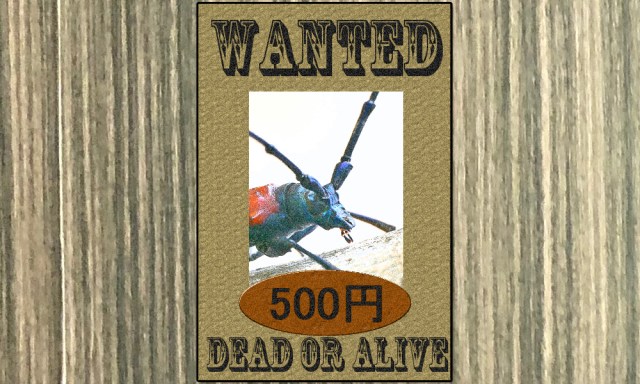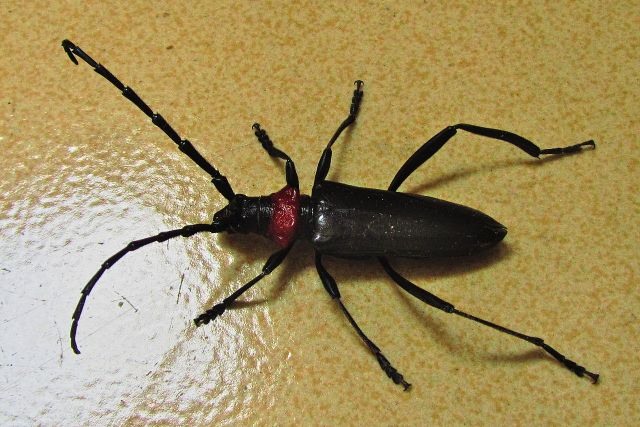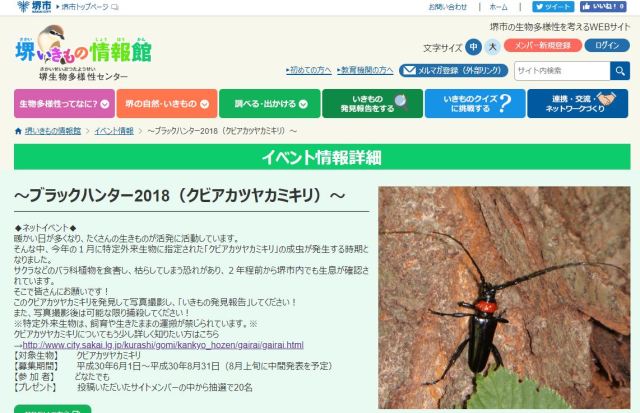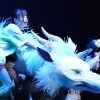
Municipalities and prefectures are hoping they can stop the dreaded red-necked longhorn beetle before they get out of hand.
Many ecologists are warning that much of Japan is on the brink of a natural disaster in the form of the red-necked longhorn beetle (Aromia bungii). Not native to Japan but popping up in Osaka, Tokyo, Tokushima, Saitama, Gunma, and Tochigi, these insects are believed to have made their way here from China or the Korean Peninsula via cargo ships.
Although they pose no threat to humans, these creatures can have a devastating effect on many of Japan’s favorite flowering trees such as sakura (cherry) and ume (Japanese apricot). Adult red-necked longhorns emerge during the summer months and lay eggs in cracks along the trunks of these trees. The larvae then hatch and begin to gnaw away at the wood for a period of one to three years.
Even worse, their depth inside the tree is right where many of the nutrients pass through, which means the tree cannot gain sustenance and beings to wither away, while simultaneously being eaten from the inside. A red-necked longhorn was only discovered in Osaka for the first time this June but already a cherry tree had succumbed to them and needed to be cut down.
▼ Red-necked longhorns are identified by their red necks, long horn-like antennae and unimaginative name
Experts warn that since these insects have no natural predators in Japan and can lay about 300 eggs at a time, their population has the potential to explode and wreak real havoc on the nation’s prettiest trees. So, some have taken steps to nip the problem in the bud and contain these invading beasts.
Sakai City has begun an open call for “black hunters” who can report sightings of red-necked longhorns so officials can monitor their movements. Any hunter who can send them a picture of the bug taken in the city along with the location and time, will get a free gift. They also kindly ask that you kill the longhorn right after taking its picture if possible.
Tokushima Prefecture, however, has been harder hit by the red-necked longhorn and has upped the ante considerably. First, the Tokushima Agriculture, Forestry and Fisheries Technology Support Center crowdfunded 5.5 million yen (US$50,000) to tackle the problem and will use part of that money to offer a 500 yen ($4.50) reward per insect to those who catch red-necked longhorns and bring them in – dead or alive presumably.
Netizens were all too eager to jump on the seemingly lucrative offer:
“A kid on summer vacation could really clean up with this!”
“So…what if I were to breed these things?”
“Well, looks like I’m going to Tokushima next week!”
“Invasive species are no joke. These things could wipe out our cherry blossoms and domestic ume production.”
“Anyone who gets fired from their job can just head over to the park.”
Amid all this clamor, we can probably expect Japan’s first and foremost bug-hunter, Teruyuki Kagawa to enter the fray. Born of a prestigious kabuki bloodline but shunned by his estranged father, Kagawa still went on to become an award-winning film and television actor.
However, it was perhaps in his role as Kamakiri Sensei on the NHK show Konchu Sugoi Ze! (Insects are Awesome!), in which he travels around Japan finding insects, that he is most loved.
It won’t be long before we can expect him to run his praying mantis claw down a chalkboard and tell everyone, “Y’all know me. Know how I earn a livin’. I’ll catch this bug for you, but it ain’t gonna be easy. Bad bug. Not like going down the pond chasin’ dragonflies and water striders. I value my neck a lot more than 500 yen, chief. I’ll find them for five, but I’ll catch them, and kill them, for ten.”
Of course, both Kagawa and those online would largely be out of luck because according to media, the 500-yen offer only appears to be aimed at local university students. That being said, they’d probably make an exception for Kamakiri Sensei in an effort to raise awareness to the problem.
However it works out, hopefully they’ll succeed in curbing the advent of the red-necked longhorn, because a Japan without sakura and ume would be like a Mr. Sato without shirt and pants – a bleak landscape indeed.
Source: Sakai City, Asahi Shimbun, Hachima Kiko
Top image: Wikipedia/Rolf Dietrich Brecher (Edited by SoraNews24)
Insert images: Wikipedia/Luojie, Sakai City



 Roses and cherry blossoms help to repel wasp attacks, according to Kochi University study
Roses and cherry blossoms help to repel wasp attacks, according to Kochi University study Sad news: 1,266 famous Tokyo plum trees get the axe to prevent spread of “plum pox”
Sad news: 1,266 famous Tokyo plum trees get the axe to prevent spread of “plum pox” KitKat releases new Japanese plum flavor to celebrate Japan’s most beautiful winter flowers
KitKat releases new Japanese plum flavor to celebrate Japan’s most beautiful winter flowers Earth Chemical to change name of insecticide products to “insect care products”
Earth Chemical to change name of insecticide products to “insect care products” Super bug — Japanese entomologist encounters a real-life titan, but of the insect variety
Super bug — Japanese entomologist encounters a real-life titan, but of the insect variety Japan’s new difficult-to-drink-from beer glass protects your liver, but it’s a brutal experience
Japan’s new difficult-to-drink-from beer glass protects your liver, but it’s a brutal experience Demon Slayer: Kimetsu no Yaiba gets new roller coaster attractions and food at Universal Studios Japan
Demon Slayer: Kimetsu no Yaiba gets new roller coaster attractions and food at Universal Studios Japan Come play hide-and-seek on a deserted Japanese island this August and November
Come play hide-and-seek on a deserted Japanese island this August and November Nintendo history you can feel – Super NES, N64, and GameCube controllers become capsule toys
Nintendo history you can feel – Super NES, N64, and GameCube controllers become capsule toys Turns out you can draw all four original starter Pokémon with just three colored pencils【Video】
Turns out you can draw all four original starter Pokémon with just three colored pencils【Video】 New Nintendo Lego kit is a beautiful piece of moving pixel art of Mario and Yoshi【Photos】
New Nintendo Lego kit is a beautiful piece of moving pixel art of Mario and Yoshi【Photos】 “The most Delicious Cup Noodle in history” – Japan’s French Cup Noodle wins our heart【Taste test】
“The most Delicious Cup Noodle in history” – Japan’s French Cup Noodle wins our heart【Taste test】 Studio Ghibli hair accessories keep your style tidy with help from Kiki, Moro, Calcifer, and more
Studio Ghibli hair accessories keep your style tidy with help from Kiki, Moro, Calcifer, and more Mr. Sato experiences the all-you-can-eat bread heaven…at Kamakura Pasta
Mr. Sato experiences the all-you-can-eat bread heaven…at Kamakura Pasta Live-action Spirited Away stage play is finally available for on-demand streaming
Live-action Spirited Away stage play is finally available for on-demand streaming Hello, cosmetics! Clinique teams up with Hello Kitty this summer for first-time collaboration
Hello, cosmetics! Clinique teams up with Hello Kitty this summer for first-time collaboration Starbucks releases a cute Frappuccino and Unicorn Cake…but not in Japan
Starbucks releases a cute Frappuccino and Unicorn Cake…but not in Japan Kyoto Tower mascot termination reveals dark side behind cute Japanese characters
Kyoto Tower mascot termination reveals dark side behind cute Japanese characters McDonald’s Japan’s Soft Twist Tower: A phantom ice cream only sold at select branches
McDonald’s Japan’s Soft Twist Tower: A phantom ice cream only sold at select branches Yabai Ramen: What makes this Japanese ramen so dangerous?
Yabai Ramen: What makes this Japanese ramen so dangerous? Finally! Nintendo Japan expands Switch 8-bit controller sales to everybody, Online member or not
Finally! Nintendo Japan expands Switch 8-bit controller sales to everybody, Online member or not Japanese government wants to build luxury resorts in all national parks for foreign tourists
Japanese government wants to build luxury resorts in all national parks for foreign tourists To combat declining birth rate, Japan to begin offering “Breeding Visas” to foreigners
To combat declining birth rate, Japan to begin offering “Breeding Visas” to foreigners 10 things you should buy at 7-Eleven in Japan
10 things you should buy at 7-Eleven in Japan Studio Ghibli releases anime heroine cosplay dresses that are super comfy to wear
Studio Ghibli releases anime heroine cosplay dresses that are super comfy to wear Woman charged for driving suitcase without a license in Osaka
Woman charged for driving suitcase without a license in Osaka Studio Ghibli unveils My Neighbour Totoro miniature house model
Studio Ghibli unveils My Neighbour Totoro miniature house model Kyoto experiencing problems with foreign tourists not paying for bus fares, but not on purpose
Kyoto experiencing problems with foreign tourists not paying for bus fares, but not on purpose Fighting mild hunger with a Japanese soda that turns into jelly in the stomach【Taste test】
Fighting mild hunger with a Japanese soda that turns into jelly in the stomach【Taste test】 Studio Ghibli’s Howl’s Moving Castle tapestry unveiled in Japan for first time
Studio Ghibli’s Howl’s Moving Castle tapestry unveiled in Japan for first time McDonald’s new Happy Meals offer up cute and practical Sanrio lifestyle goods
McDonald’s new Happy Meals offer up cute and practical Sanrio lifestyle goods Sales of Japan’s most convenient train ticket/shopping payment cards suspended indefinitely
Sales of Japan’s most convenient train ticket/shopping payment cards suspended indefinitely Sold-out Studio Ghibli desktop humidifiers are back so Totoro can help you through the dry season
Sold-out Studio Ghibli desktop humidifiers are back so Totoro can help you through the dry season Japanese government to make first change to romanization spelling rules since the 1950s
Japanese government to make first change to romanization spelling rules since the 1950s Foreigner’s request for help in Tokyo makes us sad for the state of society
Foreigner’s request for help in Tokyo makes us sad for the state of society Ghibli founders Toshio Suzuki and Hayao Miyazaki contribute to Japanese whisky Totoro label design
Ghibli founders Toshio Suzuki and Hayao Miyazaki contribute to Japanese whisky Totoro label design Doraemon found buried at sea as scene from 1993 anime becomes real life【Photos】
Doraemon found buried at sea as scene from 1993 anime becomes real life【Photos】 Tokyo’s most famous Starbucks is closed
Tokyo’s most famous Starbucks is closed Princesses, fruits, and blacksmiths: Study reveals the 30 most unusual family names in Japan
Princesses, fruits, and blacksmiths: Study reveals the 30 most unusual family names in Japan Guy learns powerful lesson: Sending 240 beetles in the mail will kill them all
Guy learns powerful lesson: Sending 240 beetles in the mail will kill them all These stunningly beautiful seasonal pink flowers from Japan are NOT cherry blossoms【Photos】
These stunningly beautiful seasonal pink flowers from Japan are NOT cherry blossoms【Photos】 Aged vending machine in Tokyo appears to sell stag beetles
Aged vending machine in Tokyo appears to sell stag beetles Store serves edible Japanese rhinoceros beetles, apparently pairs well with beer
Store serves edible Japanese rhinoceros beetles, apparently pairs well with beer Learn to make realistic-looking, edible insects with these cool tutorials【Videos】
Learn to make realistic-looking, edible insects with these cool tutorials【Videos】 Have you tried Tokushima ramen? No? You should (says our obsessed Japanese-language reporter)
Have you tried Tokushima ramen? No? You should (says our obsessed Japanese-language reporter) Give your loved ones stag beetle larvae and more this Valentine’s
Give your loved ones stag beetle larvae and more this Valentine’s We visit “Rice and Circus,” a restaurant that combines bugs and Japanese-style cooking【Photos】
We visit “Rice and Circus,” a restaurant that combines bugs and Japanese-style cooking【Photos】 Rare living male-female stag beetle is currently housed in Miyazaki prefectural museum
Rare living male-female stag beetle is currently housed in Miyazaki prefectural museum Legoland Japan celebrates first anniversary with world’s largest LEGO cherry blossom tree【Video】
Legoland Japan celebrates first anniversary with world’s largest LEGO cherry blossom tree【Video】 Now’s your once-in-12-years chance to order this special $850 pot of pickled plums!
Now’s your once-in-12-years chance to order this special $850 pot of pickled plums! Why isn’t there more deer poo in Nara Park? This very strange museum has the answer【Photos】
Why isn’t there more deer poo in Nara Park? This very strange museum has the answer【Photos】 Shikoku Island holds world landmark lookalike photography contest judged by AI
Shikoku Island holds world landmark lookalike photography contest judged by AI Anti-insect laser gun turrets designed by Osaka University, expected to work on roaches too
Anti-insect laser gun turrets designed by Osaka University, expected to work on roaches too Vending machine in Kumamoto to offer delicious insect snacks, let you munch them on the go
Vending machine in Kumamoto to offer delicious insect snacks, let you munch them on the go Won’t be in Japan in time for the cherry blossoms? Tochigi’s wisteria festival is just as magical
Won’t be in Japan in time for the cherry blossoms? Tochigi’s wisteria festival is just as magical
Leave a Reply